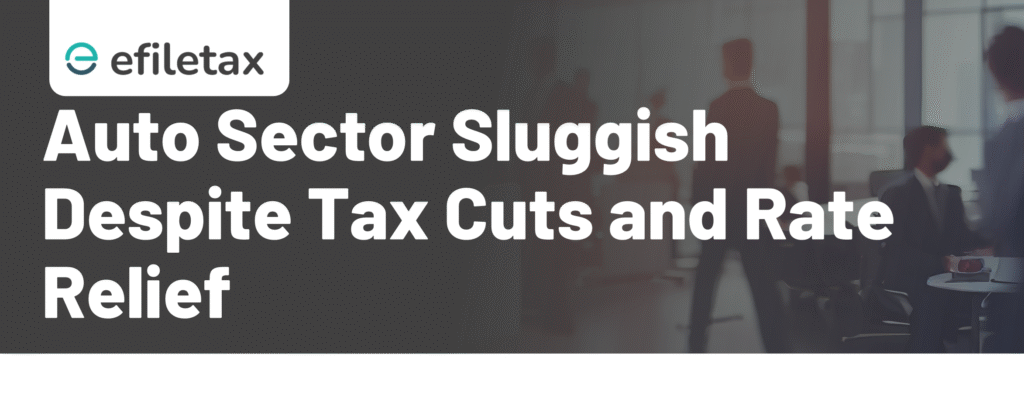
Auto Demand in India: Why Tax Cuts and Rate Drops Aren’t Enough
Despite recent income tax cuts, RBI’s lending rate easing, and favourable monsoon conditions, India’s auto sector hasn’t seen the sales revival many expected. A new report suggests consumer demand remains muted even as economic and policy indicators look supportive. Let’s break down the real reasons behind this disconnect — and what it means for taxpayers and small businesses.
What’s Happening in the Auto Sector?
According to a recent CRISIL analysis cited in Economic Times, passenger vehicle (PV) sales growth is stagnating — even after the government introduced personal income tax cuts via the new regime and the RBI kept interest rates low for over a year.
This is contrary to expectations. Normally, these three factors—tax cuts, easier auto loans, and rural boost from good rains—should lead to higher car demand.
Key Factors Behind Weak Auto Demand
Let’s decode the reasons why demand is still soft:
- Urban middle class not switching to new tax regime:
Even though the new regime offers lower slab rates (as per Budget 2023), most salaried individuals are still sticking with the old regime due to deductions like HRA, 80C, and home loan interest. Hence, no real increase in disposable income. - Loan affordability vs. EMI stress:
The repo rate has remained at 6.5% since February 2023. While this stabilised borrowing costs, auto loan EMIs remain high compared to pre-COVID levels. Urban buyers remain cautious. - Rural demand weak despite good monsoon:
Rural income recovery is slow. High inflation in essentials is eroding purchasing power. Even with good rainfall, agri-linked demand isn’t translating into two-wheeler or tractor sales as expected. - Used car boom:
Many consumers are opting for cheaper second-hand cars over new vehicles due to budget constraints. This trend has seen steady growth post-pandemic.
Tax Relief: Not Enough to Rev Up Demand
The government introduced the revised Section 115BAC in FY 2023–24, offering lower income tax rates without deductions. The new regime became default from FY 2024–25. However:
- Most individuals still prefer the old regime with deductions.
- No direct auto sector stimulus was announced in Budget 2025.
- Fuel prices and insurance costs continue to pinch.
In short, tax cuts haven’t led to extra savings significant enough to change buying behaviour.
Expert View: Focus on Micro-EMI Structures and Fleet Incentives
Tax expert and compliance advisor with Efiletax says:
“Auto manufacturers should collaborate with NBFCs and banks to offer smaller EMIs under 3–5 year plans. Also, businesses opting for fleet renewal should get GST-linked input credit clarity to push commercial vehicle demand.”
What Can Taxpayers and Small Businesses Do?
If you’re planning a vehicle purchase (personal or business use), consider:
- Comparing both tax regimes before deciding. Efiletax offers a free tax regime comparison tool.
- Use Section 80EEB (for EV loans) if applicable.
- Business users can claim depreciation under Income Tax Act for commercial vehicles.
- Track state-specific vehicle subsidies on government sites like vikaspedia.gov.in.
Income Tax and Auto Loan Impact – Quick Table
| Factor | Old Regime | New Regime (115BAC) |
|---|---|---|
| Tax Savings | High (via deductions) | Moderate |
| Disposable Income Boost | Limited (net of deductions) | Slight (if no investments) |
| Auto Loan Eligibility | Based on post-tax income | Similar, slightly higher |
| EV Purchase Benefit | 80EEB available in both regimes | Yes, if loan taken for EV |
FAQs
Q1. Can I claim car EMI as deduction in income tax?
A: No, car EMI for personal vehicles isn’t tax-deductible. Only business-use vehicles qualify for depreciation or interest deduction.
Q2. Is the new tax regime better if I plan to buy a car?
A: Not necessarily. It depends on your total deductions and cash flow needs. Use Efiletax’s calculator to compare.
Q3. Does GST apply to car purchases?
A: Yes. GST on cars ranges from 28% + cess depending on engine capacity. Input credit is restricted for personal use.
Final Take: Tax Cuts Are Not a Silver Bullet
Policy support alone isn’t driving auto sales. Disposable income, job security, and affordability remain key. For real growth, the auto sector needs a mix of targeted tax incentives, retail credit innovation, and consumer confidence revival.
Need help planning your taxes before buying a vehicle?
Efiletax helps you optimise your income tax filing and decide the best regime for big-ticket purchases.
👉 Get started with Efiletax
Summary
Income tax cuts, low interest rates, and good rains haven’t revived auto demand in India. Consumers are cautious, rural demand is weak, and used car sales are rising. Here’s why tax policy support alone isn’t enough — and what salaried and business taxpayers should consider before buying a new vehicle.